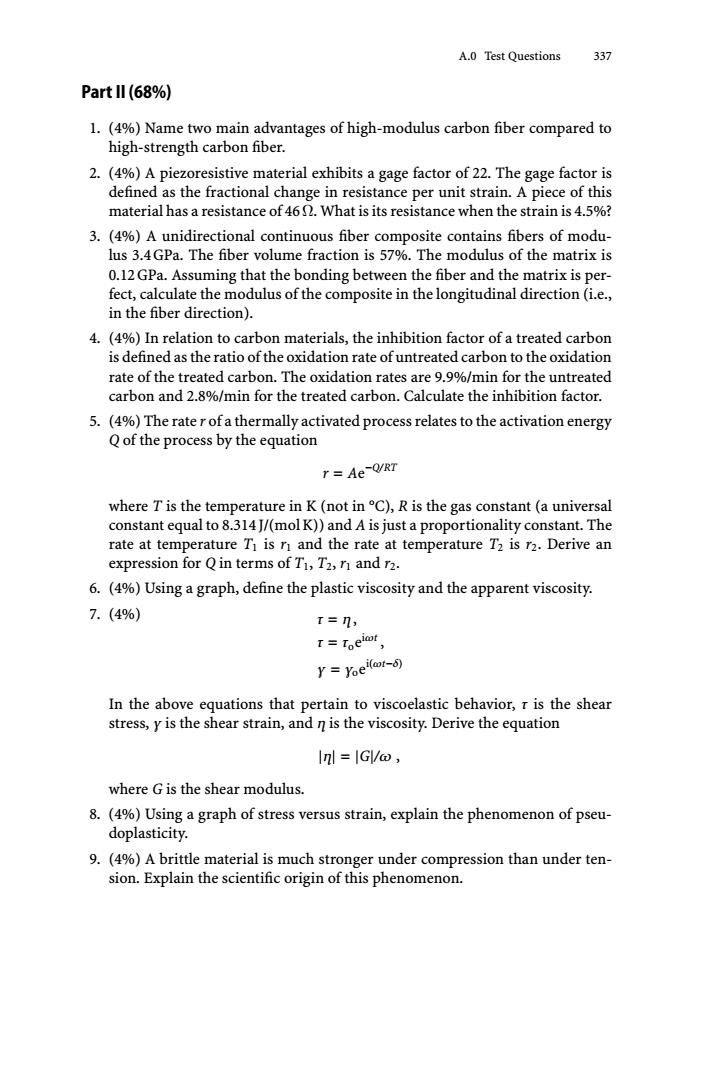正在加载图片...

A.0 Test Questions 337 Part Il(68%) 1.(4%)Name two main advantages of high-modulus carbon fiber compared to high-strength carbon fiber. 2.(4%)A piezoresistive material exhibits a gage factor of 22.The gage factor is defined as the fractional change in resistance per unit strain.A piece of this material has a resistance of 461.What is its resistance when the strain is 4.5%? 3.(4%)A unidirectional continuous fiber composite contains fibers of modu- lus 3.4GPa.The fiber volume fraction is 57%.The modulus of the matrix is 0.12 GPa.Assuming that the bonding between the fiber and the matrix is per- fect,calculate the modulus of the composite in the longitudinal direction(i.e., in the fiber direction). 4.(4%)In relation to carbon materials,the inhibition factor of a treated carbon is defined as the ratio of the oxidation rate of untreated carbon to the oxidation rate of the treated carbon.The oxidation rates are 9.9%/min for the untreated carbon and 2.8%/min for the treated carbon.Calculate the inhibition factor. 5.(4%)The rate r of a thermally activated process relates to the activation energy Q of the process by the equation r=Ae-Q/RT where T is the temperature in K(not in C),R is the gas constant (a universal constant equal to 8.314 J/(mol K))and A is just a proportionality constant.The rate at temperature Ti is ri and the rate at temperature T2 is r2.Derive an expression for Q in terms of T1,T2,r and r2. 6.(4%)Using a graph,define the plastic viscosity and the apparent viscosity. 7.(4%) T=n, T=Toeioot, Y=Yoei(t-6) In the above equations that pertain to viscoelastic behavior,r is the shear stress,y is the shear strain,and n is the viscosity.Derive the equation Inl GVa, where G is the shear modulus. 8.(4%)Using a graph of stress versus strain,explain the phenomenon of pseu- doplasticity. 9.(4%)A brittle material is much stronger under compression than under ten- sion.Explain the scientific origin of this phenomenon.A.0 Test Questions 337 Part II (68%) 1. (4%) Name two main advantages of high-modulus carbon fiber compared to high-strength carbon fiber. 2. (4%) A piezoresistive material exhibits a gage factor of 22. The gage factor is defined as the fractional change in resistance per unit strain. A piece of this material has a resistance of 46Ω. What is its resistance when the strain is 4.5%? 3. (4%) A unidirectional continuous fiber composite contains fibers of modulus 3.4GPa. The fiber volume fraction is 57%. The modulus of the matrix is 0.12GPa. Assuming that the bonding between the fiber and the matrix is perfect, calculate the modulus of the composite in the longitudinal direction (i.e., in the fiber direction). 4. (4%) In relation to carbon materials, the inhibition factor of a treated carbon is defined as the ratio of the oxidation rate of untreated carbon to the oxidation rate of the treated carbon. The oxidation rates are 9.9%/min for the untreated carbon and 2.8%/min for the treated carbon. Calculate the inhibition factor. 5. (4%) The rate r of a thermally activated process relates to the activation energy Q of the process by the equation r = Ae−Q/RT where T is the temperature in K (not in °C), R is the gas constant (a universal constant equal to 8.314J/(molK)) and A is just a proportionality constant. The rate at temperature T1 is r1 and the rate at temperature T2 is r2. Derive an expression for Q in terms of T1, T2, r1 and r2. 6. (4%) Using a graph, define the plastic viscosity and the apparent viscosity. 7. (4%) τ = η, τ = τoeiωt , γ = γoei(ωt−δ) In the above equations that pertain to viscoelastic behavior, τ is the shear stress,γ is the shear strain, and η is the viscosity. Derive the equation |η| = |G|/ω , where G is the shear modulus. 8. (4%) Using a graph of stress versus strain, explain the phenomenon of pseudoplasticity. 9. (4%) A brittle material is much stronger under compression than under tension. Explain the scientific origin of this phenomenon